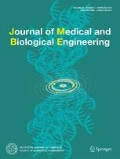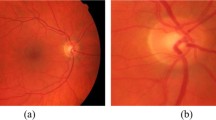Abstract
Glaucoma is the most common cause of vision loss and its identification using image processing techniques is apparently becoming more important. This paper reports the development of an automated Glaucoma detection system based on image features of eye fundus photographs, which can be used to detect Glaucoma at an early stage. We have improved the sensitivity of Glaucoma detection by using Neuroretinal rim thickness, Neuroretinal rim area and vessel information of fundus image as additional features along with the cup-to-disc ratio feature that is normally used. A unique template based correlation technique using Pearson-r coefficients is employed to extract the features like cup-to-disc ratio, rim area and rim thickness. We have used vessel information as a new feature which is obtained by segmenting the vessels by employing an undecimated isotropic wavelet transform. Analysis of the extracted proposed features stored as a data base during each visit of the patient helps in monitoring the progression of the disease. An efficient methodology is developed showing promising results with better sensitivity and specificity in the classification of Glaucoma and healthy images, respectively.









Similar content being viewed by others
References
Byahatti, A. N., Sridevi, K., & Hegadi, R. (2013). Computer based diagnosis of glaucoma using digital fundus image. Proceedings of the World Congress on Engineering. London, U.K.
Muramatsu, C., Nakagawa, T., Sawada, A., Hatanaka, Y., Hara, T., Yamamoto, T., et al. (2009). Determination of cup and disc ratio of optical nerve head for diagnosis of glaucoma on stereo retinal fundus image pairs. Proceedings of the SPIE-The International Society for Optical Engineering, 7260, 72603L-1–72603L-8.
Vijapur, N. A., & Kunte, R. S. R., (2015). Glaucoma detection by using Pearson-R correlation filter. International Conference on Communications and Signal Processing (ICCSP), pp. 1194–1198.
Vijapur, N., Srinivasa, R., & Rao, K. (2014). Improved efficiency of glaucoma detection by using wavelet filters, prediction and segmentation method. International Journal of Electronics, Electrical and Computational Systems, 3(8), 1–13.
Nayak, J., Rajendra, A., Bhat, P. S., Shetty, N., & Lim, T. C. (2009). Automated diagnosis of glaucoma using digital fundus images. Journal of Medical Systems, 33, 337–346.
Hatanaka, Y., Noudo, A., Muramatsu, C., Sawada, A., Hara, T., Yamamoto, T., & Fujita, H. (2011). Automatic measurement of cup to disc ratio based on line profile analysis in retinal images. Conference Proceedings of IEEE Engineering Medical Biological Society, pp. 3387–3390.
Cheng, J., Yin, F., Wong, D. W., Tao, D., & Liu, J. (2015). Sparse dissimilarity-constrained coding for glaucoma screening. IEEE Transactions on Biomedical Engineering, 62(5), 1395–1403.
Narasimhan, K., & Vijayarekha, K. (2011). An efficient automated system for glaucoma detection using fundus image. Journal of Theoretical and Applied Information Technology, E-ISSN: 1817- 3195 Vol. 33, pp. 104–110.
Joshi, Gopal Datt, Sivaswamy, Jayanthi, Karan, Kundun, Prashanth, R., & Krishnadas, S. R. (2010). Vessel bend-based cup segmentation in retinal images. Proceedings ofInternational Conference on Pattern Recognition, IEEE, 30, 1192–1205.
Bankhead, P., Scholfield, C. N., McGeown, J. G., & Curtis, T. M. (2012). Fast retinal vessel detection and measurement using wavelets and edge location refinement. PLoS ONE, 7(3), e32435.
Website link: https://www5.cs.fau.de/research/data/fundus-images/.
Köhler, T., Budai A., Kraus, M. F., Odstrcilik, J., Michelson, G., & Hornegger, J. (2013). Automatic No-Reference Quality Assessment for Retinal Fundus Images Using Vessel Segmentation, 26th IEEE International Symposium on Computer-Based Medical Systems 2013, Porto, pp. 95–100.
Fundus images datasets of the “Retinal image computing & understanding” research group of University of Lincoln- http://reviewdb.lincoln.ac.uk.
Lim, Jae S. (1990). Two-dimensional signal and image processing. NJ, Prentice Hall: Englewood Cliffs.
Lowell, J., Hunter, A., Steel, D., Basu, A., Ryder, R., Fletcher, E., et al. (2004). Optic nerve head segmentation. IEEE Transactions on Medical Imaging, 23(2), 256–264.
Galton, F. (1886). Regression towards mediocrity in hereditary stature. Journal of the Anthropological Institute of Great Britain and Ireland., 15, 246–263.
Jonas, J. B., Nguyen, X. N., & Naumann, G. O. (1989). Parapapillary retinal vessel diameter in normal and glaucoma eyes. I. Morphometric data. Investigative Ophthalmology & Visual Science, 30(7), 1599–1603.
Vijapur, N. A., Kunte, R. S. R., & Mudhol, R. (2013). Complimentary method of detection of Glaucoma based on ROI Pre-Processing and Vessel segmentation. In Proceedings of International Conference on Recent Trends in Communication and Computer Networks-ComNet, ACEEE Conference Proceedings Series (Vol. 5, pp. 245–249).
Acknowledgements
We would like to express our sincere gratitude to Dr. Rekha Mudhol, Head of Ophthalmology Department, K. L. E. Society’s Dr. Prabhakar Kore Hospital and Medical Research Center, for her valuable suggestions towards our research. We are thankful to Ophthalmology department, K. L. E. Society’s Dr. Prabhakar Kore Hospital & M.R.C., Belgaum, India for providing us with necessary resources required for our research and experimentation. Special thanks to High Resolution Fundus (HRF) image database providers for making samples available on the web for our experimentation. We would like to thank Research Center, E & C department of Jawaharlal Nehru National College of Engineering, Shivamogga, India and Electronics & Communication Department, K.L.E. Dr. M.S. Sheshgiri College of Engineering & Technology, Belagavi, India for technical guidance and resources without which our venture would not have been possible.
Author information
Authors and Affiliations
Corresponding authors
Rights and permissions
About this article
Cite this article
Vijapur, N.A., Kunte, R.S.R. Sensitized Glaucoma Detection Using a Unique Template Based Correlation Filter and Undecimated Isotropic Wavelet Transform. J. Med. Biol. Eng. 37, 365–373 (2017). https://doi.org/10.1007/s40846-017-0234-4
Received:
Accepted:
Published:
Issue Date:
DOI: https://doi.org/10.1007/s40846-017-0234-4




